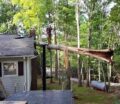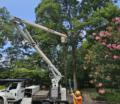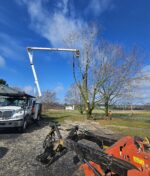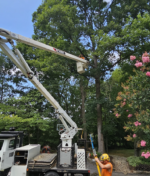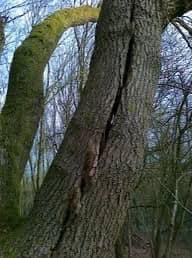
Tree failure is a major cause of property damage, especially after high winds. If the wind is strong enough, even healthy trees can be uprooted or broken.
But it might not take a storm or high winds to cause a cracked or rotted tree to fail under its own weight.
‘…trees are genetically designed to withstand storms, but all trees can fail – and defective trees fail sooner than healthy trees.
“To a professional arborist,” notes Andersen, “certain defects are indicators that a tree has an increased potential to fail.”
Cracks in tree trunks can be one of the major indicators of an unstable tree. Most cracks are caused by improper closure of wounds or by the splitting of weak branch unions. They can be found in branches, stems or roots, and vary in type and severity.
There are horizontal and vertical cracks.
Horizontal cracks run across the grain of the wood and develop just before the tree fails, making them very difficult to detect.
Vertical cracks run with the wood grain along the length of the tree and may appear as shear or ribbed cracks.
Shear cracks can run completely through the stem and separate it into two halves. As the tree bends and sways in the wind, one half of the stem slides over the other, elongating the crack. Eventually the enlarging crack causes the two halves of the stem to shear apart.
Ribbed cracks are created as the tree attempts to seal over a wound. Margins of the crack meet and mesh but are reopened due to tree movement or extremely cold temperatures. Thicker annual rings are created in order to stabilize the developing crack at the location of the wound. This forms the ribbed appearance over a period of many years.
These cracks put a tree at high risk of failure, and are especially dangerous when combined with other defects or with advanced decay.
A qualified arborist can determine the potential for failure by measuring the shell thickness in a few locations around the tree’s circumference, determining the width of the crack opening, and looking for the presence of any other type of defect.’
~Adapted from Tchukki Andersen, BCMA, CTSP and staff arborist with the Tree Care Industry Association (TCIA)
Not mentioned, but should be noted is the contraction of wood under periods of hot dry weathers also expansion under wet weather. This also is depending on species type and hard and soft types of wood. Give us a call, our Arborist will be able to analyze the Trees symptoms and failures. From there we can make a plan and assess the situation from there.

